They All Count... And Four More Come Home
A USS Abraham Lincoln (CVN 72) Sailor volunteered for a Joint
POW/MIA Accounting Command (JPAC) mission to Vietnam, in part
because of his language skills and personal ties to the Southeast
Asian country. JPAC is a military organization responsible for
recovering the remains of U.S. troops who went missing in combat
during any of the nation's past conflicts.

Chief Aviation Structural Mechanic (AW/SW) Quang Dang, of
Tacoma, Wash., born and raised in Vietnam until age 21, felt he
would be the perfect choice for the mission since he could speak
Vietnamese fluently.
"I asked my master chief if he thought it was a good idea for me
to go, and he said yes," said Dang. "So I volunteered and was
accepted." Dang was flown to the JPAC headquarters in Hawaii
where he was given an introductory course in the proper way to
excavate a crash site.
"We had to be taught how to dig," Dang said. "If you don't dig
the right way, you might miss something or damage anything you
find." After mastering the technique, Dang and his team boarded
cargo planes to begin their journey to the crash site. Once in
Vietnam, the JPAC team realized their mission was not going to be
an easy task.
 Dang and 14 others were charged with
trying to find out what happened to a U.S. Army helicopter crew 44
years earlier. In 1965, in the Gia Lai Province of Vietnam's
central highlands, a U.S. Army helicopter failed to return from a
routine mission. Rescue aircraft spent months scouring the jungle,
looking for traces of a crash and the four Soldiers who had been on
board. The crew was never heard from again and was presumed
dead.
Dang and 14 others were charged with
trying to find out what happened to a U.S. Army helicopter crew 44
years earlier. In 1965, in the Gia Lai Province of Vietnam's
central highlands, a U.S. Army helicopter failed to return from a
routine mission. Rescue aircraft spent months scouring the jungle,
looking for traces of a crash and the four Soldiers who had been on
board. The crew was never heard from again and was presumed
dead.
The mountainside's dense jungle made Dang's team's recovery
efforts impossible. The mountain was so remote and so thickly
covered in jungle, trucks couldn't be used to bring supplies to the
team. The only way to get on or off the mountain was by helicopter.
A landing zone at the mountain's top was created by the team who
blazed a trail to the bottom.
Before work at the crash site could begin, the teams built two
camps. One, at the base of the mountain, housed the 60 locals hired
by the JPAC team to assist in the excavation. The other camp,
closer to the actual crash site, housed the team throughout the
dig. A grid was designed over the crash site in four-by-four,
square-meter sections. Dang's team started in the middle of the
grid. Every shovelful of dirt was poured into a bucket, the full
bucket taken to a screening station and dumped onto the top of the
screen. Then carefully, the dirt was sifted through the screen,
leaving the dirt on the bottom and any remains on the top. The
remains were then cleaned, labeled and cataloged. As each square in
the grid was finished, the team moved outward until remains were no
longer found.
"It's a little like looking for a needle in the ocean," said
Dang. "Every bit of dirt we dug had to be sifted." In the end, the
team dug and sifted 6,000 square meters of dirt in 37 days on the
mountain. They recovered remains and artifacts of all four Soldiers
including Army air assault badges, aviator badges, dog tags and
teeth.
The remains were placed in flag draped coffins and flown to
Hickam Air Force Base in Hawaii. Team members wore their dress
uniforms and performed the solemn ceremony to honor their fallen
comrades.
"These guys have been waiting, in a jungle they didn't belong
in, for 44 years to come home," Dang said.
"Their families have been waiting and wondering. The wound never
really healed for them, and to be able to find them, identify their
remains and bring them home is beyond my feelings. I am happy and
sad for the families – happy that we are able to finally give
them answers, but sad at the same time."
The remains were turned over to JPAC's identification laboratory
for analyzing before being returned to the family members.
According to JPAC, there are more than 88,000 American service
members listed as missing in action from previous wars, and more
than 1,780 of them are from the Vietnam War. JPAC and volunteers
like Dang will continue to search for those service members until
everyone has been found. [ANN Salutes Mass Communication Specialist
Kathleen Corona, USS Abraham Lincoln (CVN 72) Media Department]
 ANN's Daily Aero-Term (11.16.25): NonApproach Control Tower
ANN's Daily Aero-Term (11.16.25): NonApproach Control Tower Aero-News: Quote of the Day (11.16.25)
Aero-News: Quote of the Day (11.16.25) ANN's Daily Aero-Linx (11.16.25)
ANN's Daily Aero-Linx (11.16.25) NTSB Final Report: Vans Aircraft Inc RV-12
NTSB Final Report: Vans Aircraft Inc RV-12 ANN FAQ: How Do I Become A News Spy?
ANN FAQ: How Do I Become A News Spy?




